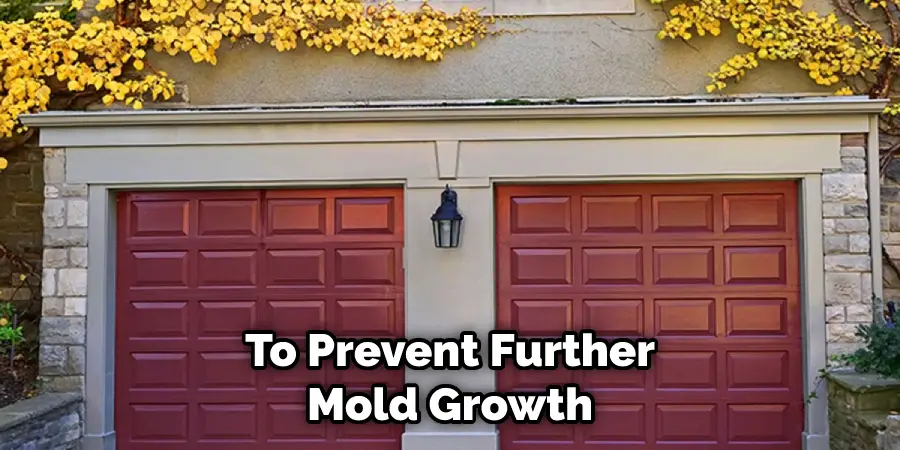Have you recently noticed mold growing on the inside of your garage door? If so, don’t panic! Removing mold from a garage door is much easier than most people think. Whether it’s due to a lack of airflow or trapped moisture, it doesn’t take long before unwanted growth starts showing up.

As a homeowner, your garage can be one of those places that easily gets cluttered and forgotten. But the truth is, it’s an integral part of any home – not only used for parking vehicles or storing goods but also for important housing valuables like tools and supplies. Unfortunately, it’s also a place where mold can build up due to dampness from weather exposure.
In this blog post, we will provide step-by-step instructions on how to remove mold from garage door—and help keep it away in the future. Keep reading to learn more!
Summary: Mold can form quickly in garages due to the warm, damp environment created by the combination of moisture, humidity, and condensation. Removing mold from garage doors safely and effectively requires an appropriate cleaning solution or combination of products. Commonly used cleaners include white vinegar, baking soda, and hydrogen peroxide.
What Will You Need?
- Protective gear: gloves, goggles, and a face mask
- Cleaning supplies: bleach or other mold-removing cleaners, sponges, microfiber cloths/rags, dehumidifier, or air conditioning unit
- Vacuum cleaner with attachments (for harder to reach areas)
- Scrub brushes or toothbrushes (for harder to reach areas)
- Bucket of water with a small amount of detergent mixed in
- Hose or spray nozzle to rinse the area thoroughly once you are done cleaning
Once you have gathered all these things, you are ready to remove the mold from your garage door. Here is a step-by-step guide to help you along.
15 Easy Steps on How to Remove Mold From Garage Door
Step 1: Gather Necessary Supplies
Before beginning the mold removal process, gather the necessary supplies and protective gear. You will need:
- A bucket
- Warm water
- Dish soap
- Baking soda or vinegar
- A soft brush or sponge
- A stiff brush (for stubborn mold)
- A garden hose or pressure washer (optional)
- Rubber gloves
- Safety goggles
- A face mask or respirator (preferably N95 or higher)
Step 2: Prepare the Cleaning Solution
Fill a bucket with warm water and add a few drops of dish soap. For a more potent mold-killing solution, add one cup of baking soda or one cup of white vinegar to the bucket. Both baking soda and vinegar are natural, non-toxic mold killers that are safe for use on most surfaces.
Step 3: Wear Protective Gear
Before starting the mold removal process, put on your rubber gloves, safety goggles, and face mask or respirator. Mold spores can be harmful when inhaled or come into contact with the skin, so it’s essential to protect yourself during the cleaning process.
Step 4: Wet the Garage Door
Using a garden hose or pressure washer, thoroughly wet the garage door. This will help to loosen the mold and make it easier to remove. If you don’t have access to a hose or pressure washer, simply wet the door using a sponge and your cleaning solution.
Step 5: Apply the Cleaning Solution
Dip your soft brush or sponge into the cleaning solution and begin to scrub the moldy areas of the garage door. Use gentle pressure to avoid damaging the door’s surface, especially if it is made of wood or a delicate material. For stubborn mold or areas with heavy growth, use a stiff brush to scrub more vigorously.
Step 6: Rinse the Garage Door
After scrubbing the moldy areas, rinse the garage door thoroughly with water to remove the cleaning solution and any remaining mold spores. Use a garden hose or pressure washer for a thorough rinse, or simply use a sponge and clean water if a hose is not available.
Step 7: Dry the Garage Door
Allow the garage door to air dry or use a clean, dry cloth to wipe away any excess moisture. Ensuring that the door is completely dry will help to prevent mold from returning.
Step 8: Inspect for Remaining Mold
After the garage door has dried, inspect the areas where mold was present to ensure that it has been completely removed. If any mold remains, repeat steps 4 through 7 until the mold is gone.
Step 9: Prevent Future Mold Growth
To prevent mold from returning, take measures to reduce moisture in and around your garage:
- Ensure that your garage has proper ventilation to allow moisture to escape.
- Use a dehumidifier to reduce humidity levels in the garage, especially during damp or humid weather.
- Inspect the garage door’s weatherstripping and replace it if it is worn or damaged, as this can allow moisture to enter the garage.
- Regularly clean your garage door and check for signs of mold, especially during periods of high humidity or after heavy rainfall.
Step 10: Dispose of Cleaning Materials Safely
After removing the mold from your garage door, dispose of your cleaning materials safely to avoid spreading mold spores to other areas. Place used brushes, sponges, and gloves in a sealed plastic bag and dispose of them in an outdoor trash receptacle. Wash reusable items, such as buckets and cloths, thoroughly in hot water and detergent to kill any remaining mold spores.
By following these steps, you can effectively remove mold from your garage door and take measures to prevent future mold growth. Regular inspection and cleaning, combined with proper ventilation and humidity control, will help to keep
your garage door mold-free and in good condition. Remember to always wear protective gear when handling mold and to dispose of contaminated materials safely to minimize the risk of spreading mold spores to other areas.
Step 11: Maintain the Area Around Your Garage Door
Keep the area around your garage door clean and free of debris, such as leaves, grass clippings, and dirt. These materials can trap moisture and create a breeding ground for mold growth. Regularly sweep or hose down the area to prevent the buildup of debris.
Step 12: Regularly Inspect for Water Damage or Leaks
Water damage or leaks in your garage can contribute to mold growth on your garage door. Inspect the garage regularly for signs of water damage, such as staining, peeling paint, or warped materials. If you discover a leak or water damage, address the issue promptly to prevent further mold growth.
Step 13: Consider Painting or Sealing Your Garage Door
If your garage door is made of wood or another porous material, consider painting or sealing it to protect against moisture and mold. Use a high-quality exterior paint or sealant that is designed for use on garage doors and follow the manufacturer’s instructions for application. This protective barrier can help to prevent mold from taking hold on your garage door.
Step 14: Educate Yourself About Mold
Learn about the different types of mold and the conditions that promote mold growth. Understanding what mold looks like and the factors that contribute to its growth can help you to identify and address mold issues more effectively.
Step 15: Keep an Emergency Mold Removal Kit
Prepare an emergency mold removal kit that includes the necessary cleaning supplies, protective gear, and disposal materials. Having these items on hand will allow you to address mold issues promptly and minimize the spread of mold spores.
In conclusion, removing mold from your garage door requires a combination of cleaning, maintenance, and prevention measures. By following these steps and taking a proactive approach to mold management, you can keep your garage door mold-free and in good working order. Always prioritize safety when dealing with mold and consult a professional if you are unsure about how to handle a mold issue or if the problem persists despite your efforts.
5 Additional Tips and Tricks
- To remove mold from your garage door, clean the door’s surface with a damp cloth or sponge.
- Mix a warm water solution and laundry detergent in a clean bucket. Gently scrub the door with this solution, focusing on any areas that are heavily stained or covered in mold.
- If your garage door is made from wood, you may also want to consider using a commercial mold remover product specifically designed for use on wood surfaces.
- Avoid using bleach or other harsh chemicals to clean your garage door, as these can damage the door’s surface and leave it more prone to mold growth in the future.
- To prevent mold from growing on your garage door in the first place, make sure to regularly clean and dry your door and keep it well-ventilated at all times. This can help prevent the growth of mold spores and other dampness-loving bacteria on your garage door.
If you follow these tips and tricks for removing mold from garage doors, you can keep your garage looking clean and fresh and prevent harmful mold growth in your home. Good luck!
Why is Mold Growing on Everything in My Garage?
Mold is a fungus that can grow on various surfaces, such as wood, cloth, and other porous materials. In the case of your garage door, there are likely some conditions in your garage that are conducive to mold growth, such as high levels of moisture or humidity.
Additionally, if you have an air conditioning unit or dehumidifier installed in your garage, this may also contribute to mold spores’ growth.
To prevent further mold growth on your garage door, it is important to address any underlying issues that may be leading to this problem. This could include installing a dehumidifier or AC unit in your garage to help keep moisture levels low, regularly cleaning and drying the surface using a damp cloth or sponge, and taking other steps to reduce dust buildup and debris in your garage.

Additionally, investing in a quality sealant or coat of paint for your garage door may be a good idea, which can help protect it from moisture and other environmental factors over time. With these simple steps, you can keep your garage door mold-free for years to come!
Conclusion
Although mold can be a pain to remove, it is not impossible. With the right tools and time, you can return your garage door to its original condition.
Now that you know how to remove mold from garage door, you can keep it looking new for years to come. Just be sure to clean it regularly and check for mold growth periodically. With a little bit of care, your garage door will last for many years.
Hopefully, this information has been helpful, and you are now equipped with the knowledge needed to remove mold from your garage door effectively. Good luck!
I am Rick. I grew up helping my dad with his handyman service. I learned a lot from him about how to fix things, and also about how to work hard and take care of business. These days, I’m still into fixing things- only now, I’m doing it for a living.
I’m always looking for new ways to help people grow and develop. That’s why I have created this blog to share all my experience and knowledge so
that I can help people who are interested in DIY repair.

